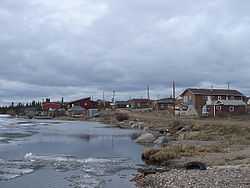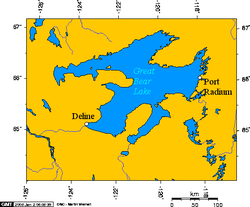Deline
| Deline Délı̨ne | |
|---|---|
| Charter Community | |
 | |
 Great Bear Lake, NWT, Canada | |
 Deline Location of Deline within Canada | |
| Coordinates: 65°11′12″N 123°25′18″W / 65.18667°N 123.42167°WCoordinates: 65°11′12″N 123°25′18″W / 65.18667°N 123.42167°W | |
| Country | Canada |
| Territory | Northwest Territories |
| Region | Sahtu Region |
| Constituency | Sahtu |
| Census division | Region 2 |
| Charter Community | 1 April 1993 |
| Government | |
| • Chief | Leonard Kenny |
| • Senior Administrative Officer | Rosy Ann Tutcho |
| • MLA | Norman Yakeleya |
| Area[1] | |
| • Land | 79.44 km2 (30.67 sq mi) |
| Elevation | 214 m (702 ft) |
| Population (2011)[1] | |
| • Total | 472 |
| • Density | 5.9/km2 (15/sq mi) |
| Time zone | Mountain (MST) (UTC-7) |
| • Summer (DST) | MDT (UTC-6) |
| Canadian Postal code | X0E 0G0 |
| Area code(s) | 867 |
| Telephone exchange | 589 |
| - Living cost | 172.5A |
| - Food price index | 172.1B |
| Website | www.deline.ca |
|
Sources: Department of Municipal and Community Affairs,[2] Prince of Wales Northern Heritage Centre,[3] Canada Flight Supplement[4] ^A 2009 figure based on Edmonton = 100[5] ^B 2012 figure based on Yellowknife = 100[5] | |
The Charter Community of Délįne (pronounced "day-li-neh") is located in the Sahtu Region of the Northwest Territories, Canada on the western shore of Great Bear Lake and is 544 km (338 mi) northwest of Yellowknife. Délįne means "where the waters flow", a reference to the headwaters of the Great Bear River, Sahtúdé.
History

According to early records, a trading post was established in this general area as early as 1799 by the North West Company but it did not last very many years. In 1825, Peter Warren Dease of the Hudson's Bay Company (HBC) erected an outpost here as the staging area and winter quarters for Sir John Franklin's second Arctic expedition (1825–1827). It became known as Fort Franklin. Sir John Franklin's diary records that his men played ice sports very similar to what we now call hockey. As such, the modern-day town promotes itself as one of the birthplaces of the sport of ice hockey.[6]
The HBC returned and established a post called Fort Norman a short distance west, and across the lake narrows, from John Franklin's original post, between 1863 and 1869, and then relocated Fort Norman to its current location at the confluence of the Mackenzie and Bear Rivers (now Tulita). [7]
Fort Franklin as a modern era trading post of the HBC was not established until later in the 19th century. It was constructed at one of the most productive Dene fisheries in the Mackenzie River drainage basin and was for the benefit of the Dene people who lived in near isolation along the shores of Great Bear Lake.
The area became prominent when pitchblende was discovered at the Eldorado Mine, some 250 km (160 mi) away, on the eastern shore, at Port Radium. During World War II, the Canadian Government took over the mine and began to produce uranium for the then-secret American nuclear bomb project. Uranium product was transported from Port Radium by barge across Great Bear Lake where a portage network was established along the Bear River, across the bay from Fort Franklin, where many of the Dene men found work. As the risks associated with radioactive materials were not well understood nor communicated, it is believed that many of the Dene were exposed to dangerous amounts of radiation.[8]
The name of Fort Franklin was changed on 1 June 1993 to Délįne, which means "where the waters flow", a reference to the headwaters of the Great Bear River, Sahtúdé.
Nearby Saoyú-ʔehdacho, the largest National Historic Site of Canada in the country, was designated in 1997 and is jointly administered by Parks Canada and the Déline First Nation.
Archaeology
John Franklin's 1825-1827 outpost was excavated by the Prince of Wales Northern Heritage Centre in 1987. The excavation uncovered beads, rings, and buttons indicating the extent of trade between the Dene and Europeans. The site is protected by the Northwest Territories Archaeological Sites Regulations. In 1996, the site was designated a National Historic Site of Canada.[9]
Climate
| Climate data for Deline Airport | |||||||||||||
|---|---|---|---|---|---|---|---|---|---|---|---|---|---|
| Month | Jan | Feb | Mar | Apr | May | Jun | Jul | Aug | Sep | Oct | Nov | Dec | Year |
| Record high humidex | 2.8 | 0.5 | 3.8 | 16.6 | 22.8 | 29.8 | 33.5 | 31.8 | 22.9 | 20.5 | 2.4 | 0.3 | 33.5 |
| Record high °C (°F) | 2.5 (36.5) |
1.0 (33.8) |
4.0 (39.2) |
16.0 (60.8) |
22.5 (72.5) |
29.3 (84.7) |
31.0 (87.8) |
32.0 (89.6) |
23.5 (74.3) |
20.8 (69.4) |
4.8 (40.6) |
3.3 (37.9) |
32.0 (89.6) |
| Average high °C (°F) | −20.9 (−5.6) |
−18.5 (−1.3) |
−13.9 (7) |
−1.9 (28.6) |
7.4 (45.3) |
16.8 (62.2) |
19.4 (66.9) |
16.6 (61.9) |
10.2 (50.4) |
−0.8 (30.6) |
−11.5 (11.3) |
−17.6 (0.3) |
−1.2 (29.8) |
| Daily mean °C (°F) | −25.0 (−13) |
−23.2 (−9.8) |
−19.5 (−3.1) |
−7.7 (18.1) |
2.5 (36.5) |
10.7 (51.3) |
13.3 (55.9) |
11.2 (52.2) |
5.7 (42.3) |
−3.9 (25) |
−15.4 (4.3) |
−22.0 (−7.6) |
−6.1 (21) |
| Average low °C (°F) | −28.9 (−20) |
−27.8 (−18) |
−25.1 (−13.2) |
−13.6 (7.5) |
−2.5 (27.5) |
4.4 (39.9) |
7.2 (45) |
5.8 (42.4) |
1.3 (34.3) |
−7.0 (19.4) |
−19.2 (−2.6) |
−26.3 (−15.3) |
−11.0 (12.2) |
| Record low °C (°F) | −49.1 (−56.4) |
−43.3 (−45.9) |
−43.3 (−45.9) |
−35.0 (−31) |
−23.3 (−9.9) |
−4.0 (24.8) |
−1.8 (28.8) |
−4.9 (23.2) |
−13.3 (8.1) |
−29.7 (−21.5) |
−37.4 (−35.3) |
−43.0 (−45.4) |
−49.1 (−56.4) |
| Record low wind chill | −57.2 | −54.0 | −55.3 | −40.4 | −27.6 | −6.4 | 0.0 | −3.6 | −16.3 | −34.4 | −46.7 | −54.7 | −57.2 |
| Average precipitation mm (inches) | 10.3 (0.406) |
11.2 (0.441) |
10.3 (0.406) |
10.1 (0.398) |
14.8 (0.583) |
24.3 (0.957) |
40.3 (1.587) |
43.2 (1.701) |
39.5 (1.555) |
31.1 (1.224) |
21.7 (0.854) |
11.9 (0.469) |
268.7 (10.579) |
| Average rainfall mm (inches) | 0.0 (0) |
0.0 (0) |
0.0 (0) |
0.1 (0.004) |
12.2 (0.48) |
24.2 (0.953) |
40.3 (1.587) |
43.2 (1.701) |
37.1 (1.461) |
4.9 (0.193) |
0.4 (0.016) |
0.0 (0) |
162.3 (6.39) |
| Average snowfall cm (inches) | 13.0 (5.12) |
16.9 (6.65) |
17.1 (6.73) |
12.3 (4.84) |
3.4 (1.34) |
0.2 (0.08) |
0.0 (0) |
0.0 (0) |
2.4 (0.94) |
32.2 (12.68) |
35.2 (13.86) |
17.3 (6.81) |
150.0 (59.06) |
| Avg. precipitation days (≥ 0.2 mm) | 5.4 | 6.8 | 7.5 | 3.9 | 6.1 | 8.0 | 10.4 | 12.3 | 12.4 | 12.4 | 10.1 | 7.2 | 102.4 |
| Avg. rainy days (≥ 0.2 mm) | 0.0 | 0.0 | 0.0 | 0.2 | 4.5 | 8.0 | 10.4 | 12.3 | 11.8 | 2.4 | 0.1 | 0.0 | 49.7 |
| Avg. snowy days (≥ 0.2 cm) | 6.7 | 7.5 | 9.4 | 4.2 | 1.7 | 0.1 | 0.0 | 0.0 | 0.9 | 10.5 | 11.4 | 8.9 | 61.4 |
| Average relative humidity (%) | 74.9 | 76.1 | 76.7 | 75.0 | 63.0 | 54.5 | 58.2 | 62.1 | 65.7 | 82.6 | 82.5 | 76.1 | 70.6 |
| Source: Environment Canada Canadian Climate Normals 1981–2010[10] | |||||||||||||
Land claims
Délįne is represented by the Deline First Nation and belongs to the Sahtu Dene Council.[11] Through the council they completed negotiations with the Government of Canada for a comprehensive land claim settlement in 1993.
Demographics
| Historical population | ||||||||||||||||||||||||||||||||||||||||||||||||||||||||||
|---|---|---|---|---|---|---|---|---|---|---|---|---|---|---|---|---|---|---|---|---|---|---|---|---|---|---|---|---|---|---|---|---|---|---|---|---|---|---|---|---|---|---|---|---|---|---|---|---|---|---|---|---|---|---|---|---|---|---|
|
| |||||||||||||||||||||||||||||||||||||||||||||||||||||||||
| Sources: NWT Bureau of Statistics (2001 - 2012)[5] | ||||||||||||||||||||||||||||||||||||||||||||||||||||||||||
The population at the 2011 census was 472, a decrease of 10.1% from the 2006 census.[1] In the 2006 Census there 495 Aboriginal people made up of 465 North American Indians, Sahtu Dene people speaking North Slavey, 15 Métis people and 15 Inuit.[12] In 2012 the Government of the Northwest Territories reported that the population was 559 with an average yearly growth rate of -0.1% from 2001.[5]
See also
References
- ↑ 1.0 1.1 1.2 Déline, CC Northwest Territories (Census subdivision)
- ↑ "NWT Communities - Deline". Government of the Northwest Territories: Department of Municipal and Community Affairs. Retrieved 2013-01-21.
- ↑ Prince of Wales Northern Heritage Centre - official names
- ↑ Canada Flight Supplement. Effective 0901Z 24 July 2014 to 0901Z 18 September 2014
- ↑ 5.0 5.1 5.2 5.3 Deline - Statistical Profile at the GNWT
- ↑ Boswell, Randy (17 September 2011). "Deline, NWT: The ‘birthplace’ of hockey?". NunatsiaqOnline. Nunatsiaq News. Archived from the original on 9 February 2015. Retrieved 9 February 2015.
- ↑ Petitot, Emile. Travels Around Great Slave and Great Bear Lakes, 1862–1882. Toronto: The Champlain Society, 2005.
- ↑ They Never Told Us These Things
- ↑ Déline Fishery / Franklin's Fort National Historic Site of Canada. Canadian Register of Historic Places. Retrieved 4 October 2013.
- ↑ "Deline A" (CSV (3069 KB)). Canadian Climate Normals 1981–2010. Environment Canada. Climate ID: 22010KA. Retrieved 2014-01-09.
- ↑ Indian and Northern Affairs Canada
- ↑ 2006 Aboriginal Population Profile
- John Price, "Our own atomic victims," Victoria Times-Colonist
External links
| Wikimedia Commons has media related to Deline. |
| ||||||||||||||||||||||||||||||||||||||||||||||||||||||||||||||||||||||||||||||||||||||||||